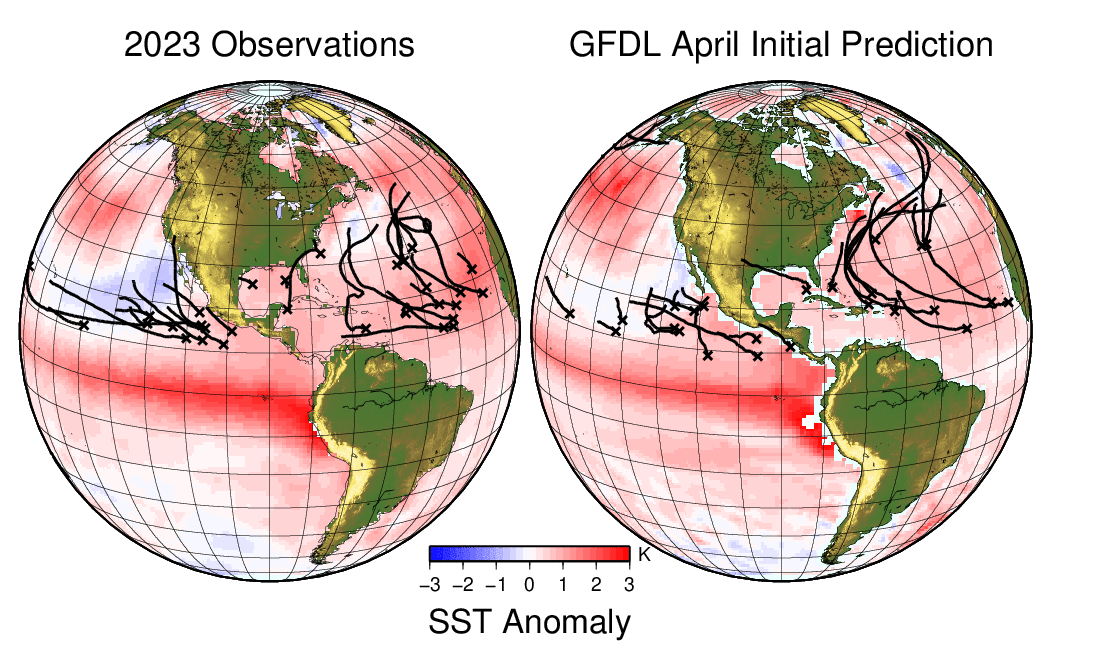December 6th, 2023
If you live along a U.S. coast, you’re likely familiar with NOAA’s seasonal hurricane forecasts. Released each year in May (and updated in August for the Atlantic region), these forecasts provide an important preview of what each year’s Atlantic and Pacific hurricane seasons will bring.
“Seasonal predictions provide valuable lead time for communities to prepare for potential hurricanes,” said Hiro Murakami, a research physical scientist at GFDL. “This allows for early warning systems to be activated, facilitating organized evacuations and ensuring that residents have sufficient time to secure their homes and belongings.”

The forecasts also allow authorities to plan for the upcoming season, prepping emergency response teams, stocking up on supplies, making sure evacuation plans are up to date, and more. But what data goes into these seasonal hurricane predictions, and how does NOAA make them?
Seasonal hurricane predictions are a bit like a large puzzle, with several pieces coming together to create a reliable forecast. Murakami said that experts typically start analyzing environmental data in the months leading up to hurricane season (which typically starts on June 1). Many environmental factors are considered in developing a hurricane forecast, including sea surface temperature; atmospheric conditions like wind patterns and humidity levels; and El Niño and La Niña events. Information from past hurricane seasons is also considered, as historical trends can help inform future hurricane activity. Statistical, dynamical, and hybrid models then analyze this data and start to form the forecasts released to the public each year.
GFDL provides the dynamical forecast component to this process. Dynamical models use mathematical equations to simulate ocean and atmosphere conditions, as opposed to statistical models, which rely more heavily on historical data. Murakami noted that, given the high number of unprecedented events and hurricane seasons over the last several years, relying solely on historical data does not always ensure accurate forecasts.
“Dynamical forecasts, such as those provided by GFDL models, are based on complex physical equations that simulate the behavior of the atmosphere and oceans,” Murakami said. “This physics-based approach allows for a more realistic representation of the underlying processes governing hurricane development, capturing the intricate interactions between different environmental factors.”
There are two main steps to creating these dynamical predictions, said Tom Delworth, senior scientist at GFDL. First, scientists use GFDL’s SPEAR seasonal forecasting model to predict sea surface temperatures during hurricane season. “The SPEAR model itself produces one set of hurricane predictions,” Delworth said. Then, scientists use these predicted sea surface temperatures to inform a second model, which predicts seasonal hurricane activity.
GFDL’s contribution of dynamical predictions to the seasonal hurricane forecast is important for four reasons, Murakami said. First, they are sophisticated and highly accurate models that take into account a wide range of factors that influence hurricane development. Second, they make their predictions based on conditions across the globe – an important feature, because hurricanes aren’t just influenced by the conditions in the area in which they form. Third, they’ve proved reliable in predicting hurricane activity in past seasons, adding credibility to their predictions. And fourth, they contribute to the ensemble approach that NOAA’s Climate Prediction Center uses to make its seasonal hurricane forecasts, providing a range of possible outcomes.
Having that range of possible outcomes helps NOAA experts assess and understand the uncertainty that’s associated with seasonal forecasts, to make educated predictions. This Atlantic hurricane season, for instance, proved challenging for forecasters. A total of 20 named storms formed in the Atlantic this year, marking 2023 as an “active” hurricane season. In May, NOAA predicted a normal season with 12-17 named storms, but the agency increased its prediction in its August update, amending the forecast to “above-normal,” with 14-21 named storms.
“The environmental conditions were such that they could have resulted in either an active or an inactive hurricane season,” Murakami said of the conditions leading up to the May forecast. “One of the GFDL dynamical models notably forecasted an active hurricane season accurately, even from the initial predictions in April.”
Scientists at GFDL are working to improve their dynamical predictions for seasonal hurricane forecasts. Murakami said that there is hope that artificial intelligence can one day be incorporated into the prediction process, and scientists are also working to incorporate the context of climate change into predictions.
“For example, when there is a prediction of an active season, we are investigating the extent to which anthropogenic climate changes contribute to the occurrence of such active hurricane seasons,” Murakami said. “This research is valuable for understanding the impact of underlying climate changes on hurricane activity at the seasonal timescale.”
Learn more about NOAA GFDL’s models and NOAA’s hurricane forecasts.

Right: Similar to the left panel, but predicted by a GFDL seasonal prediction model initialized on April 1st.


